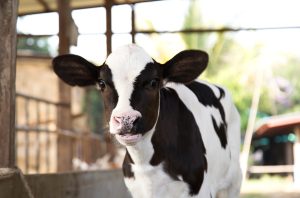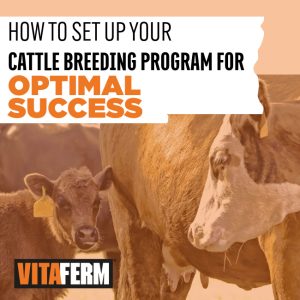Good things don’t always come in small packages. Take for instance, the fly. This little nuisance is known to cause at least $1.5 billion in losses to the cattle industry annually. Break that down, and it could be costing you, the producer, $30-$50 per pair if you are not engaging in effective fly control management.
But how can something so small cause so many challenges and economic loss? What can you do about it? During a recent conversation, Kevin Glaubius, Director of Nutrition at BioZyme® Inc., shares the real stress and damage that flies cause and some ways to avoid these stressors.
Q: How does the little fly have such a big impact on the cow herd?
Glaubius: The goal for the producer is to maintain weaning weights that are as close as possible to the genetic potential of the mating. Any type of stress, including flies, detracts from that. Not only do some species of flies land on and take 20-30 blood meals per cow a day, causing her to lose up to a pint of blood per day, the various species of flies can serve as a general distraction, keeping cattle from grazing. They also carry and transmit diseases like pink eye and anaplasmosis.
Q: Are you saying all of this damage is caused by one type of fly?
Glaubius: No. Although there are many species of flies in the world, three primarily impact cattle. The horn fly is perhaps the most detrimental to the herd in a pasture situation. Horn fly infestations cause irritation, blood loss, decreased grazing efficiency, reduced weight gain in calves and diminished milk production in the lactating cow. Horn flies will land on the backs, sides, bellies and poll. The female will lay eggs in fresh manure, and eggs will typically hatch within one week. The horn fly can live up to 20 days.
Face flies are a non-biting, non-sucking fly that resembles the appearance of a house fly but is larger. The face fly feeds on animal secretions and fecal liquids. The adult female face flies cluster around the animal’s eyes, mouth and muzzle, causing extreme irritation. Face flies will also feed on blood and other secretions around wounds or feeding sites from horn or stable flies and are an important vector for pink eye.
Stable flies are another biting and sucking fly. They are most commonly found in feedlots, dairies and pasture cattle. Like the horn fly, stable flies, feed off blood and primarily feed on the front legs of the cattle. Their bites are painful causing the cattle to stomp their legs, bunch up in the pasture or find water to stand in to avoid being bitten. The female stable fly lays eggs in spoiled or fermenting organic matter mixed with animal manure, soil and moisture.
Q: If I am feeding a ClariFly mineral will that keep my fly counts down and help my cow herd?
Glaubius: A common misconception by producers who feed a fed-through mineral with fly control like ClariFly, is that they won’t see flies, and that isn’t the case. Although ClariFly will prevent the birth and growth of horn flies, stable flies, face flies and house flies, it won’t get rid of the fly population that is already present. The key to success with feeding ClariFly is to start early enough in the season before the flies repopulate. This allows for the ClariFly to pass through the digestive system via manure and therefore when flies lay their eggs in the manure – it will eradicate the next population.
Q: If a mineral with ClariFly doesn’t control all of a producers’ flies, what can the producer do to reduce fly pressure?
Glaubius: There are a number of different fly control mechanisms out there, however, to get the most effectiveness, you will want to use a combination of two or more fly control methods. In addition to feeding a mineral with ClariFly, you might also use a product like a dust bag or a fly tag. There are also fly sprays and injectables available that offer extended fly control as well as controlling worms. All of these are good options, but they make great options when partnered together.
Q: What if a producer is looking for a more natural way to control flies and insects?
Glaubius: There have been some preliminary trials that show that garlic does reduce fly pressure on cattle, when fed in a mineral. One Canadian study shows that the flies that landed on grazing cattle were reduced by half on cattle fed garlic, versus the control group that received no garlic. Customers that have been feeding the VitaFerm® HEAT® mineral that contains garlic say they still see flies hovering around their cattle, but not landing on them. Cows are also calmer and not bunched up, indicating reduced fly pressure. The mode of action for garlic is different compared to a mineral with ClariFly that works through the digestive system into the manure, where horn flies breed. With garlic, the mode of action is the scent through the animal’s breath and skin excretion. After the cow eats the mineral, it is absorbed. Then when she licks herself or her calf, it is believed that the scent repels the flies and other insects, giving producers one more fly control resource.
Not only does VitaFerm HEAT help with fly control, but its primary purpose is to prevent heat stress through the use of Amaferm®, a precision-based prebiotic, and a combination of plant extracts that help maintain the animal’s core body temperature. VitaFerm HEAT is an ideal summertime mineral that helps minimize the negative effects of two stressors simultaneously.
Q: Can you suggest any other management practices to control flies?
Glaubius: Always make sure to have as much waste and old feed or hay cleaned up as possible and kept away from barns and cows. Minimize the areas where flies can breed. With an overly wet year like we’ve had this year, make sure there is no extra standing water around and keep your pens a clean as possible.
Q: What final advice can you give producers as it pertains to fly control?
Glaubius: If we can minimize the amount of stress from fly pressure, we can make a significant improvement in gain in these animals. The economic value is enough to justify using one or two methods to minimize the impact of fly pressure. With today’s cattle prices, it doesn’t take very many pounds to add up to that $30 loss. At $1.50 per pound, that is 15 pounds of weight gain over a five-month period, or .10 pound per day. With no stress that would make a difference.
Getting your cattle to gain and grow is a big goal. Don’t let a little nuisance like a fly interfere with your cattle’s performance. A high-quality mineral like VitaFerm HEAT or VitaFerm® HEAT® with ClariFly® combined with a clean environment and another fly control method will help keep your cattle healthy and performing.



